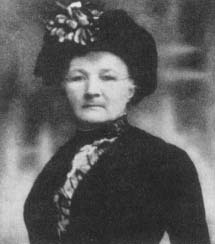Mother Jones Court-Martial: 1913
Yellow Fever And Chicago Fire
There in 1861 she married iron molder George E. Jones, a worker dedicated to the union viewpoint. In six years, the couple produced four children, but in 1867, within one week, yellow fever killed all four and then their father. Widow Jones returned to dressmaking in Chicago.
For three days in October 1871, the Great Chicago Fire ravaged the city. Mary Harris Jones's home and shop became rubble. Shortly thereafter she joined the Knights of Labor, an organization determined to unite workers in a single cooperative system.
Working as a seamstress for Chicago's well-to-do, Jones pondered her late husband's convictions, the goals of the Knights of Labor, the hungry wretches shivering in one-room shantytown "houses," and those oblivious to it all—her wealthy employers. Soon she was recruiting new Knights.
In 1877, the fourth year of a grueling depression, railroad workers struck over reduced wages. Marching on picket lines in Pittsburgh, Jones watched 6,000 workers defy strike-breaking troops, dispatched by the governor. After the soldiers killed 26 of their comrades, the strikers destroyed 105 locomotives and 79 railroad buildings before
 Mary "Mother" Jones, 83-year-old labor agitator.
President Rutherford B. Hayes sent in federal troops. Mary Jones became convinced that, while workers could exercise power, private industry commanded the federal troops.
Mary "Mother" Jones, 83-year-old labor agitator.
President Rutherford B. Hayes sent in federal troops. Mary Jones became convinced that, while workers could exercise power, private industry commanded the federal troops.
Additional topics
Law Library - American Law and Legal InformationNotable Trials and Court Cases - 1883 to 1917Mother Jones Court-Martial: 1913 - Yellow Fever And Chicago Fire, "mother" Of All American Workers, "'i Warn This Little Governor"